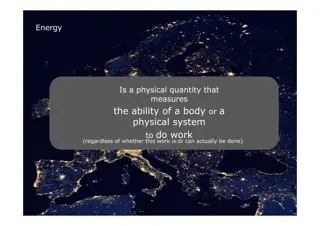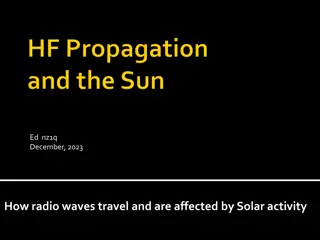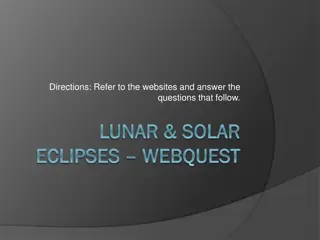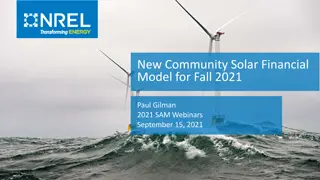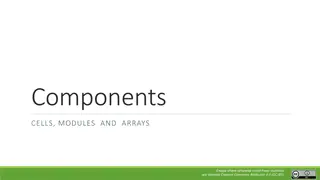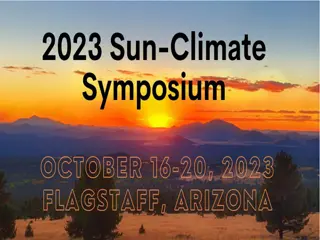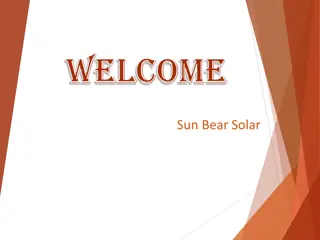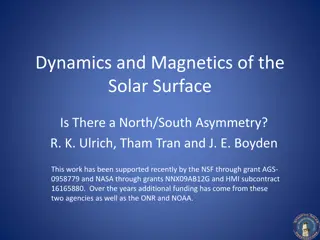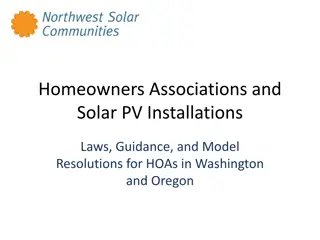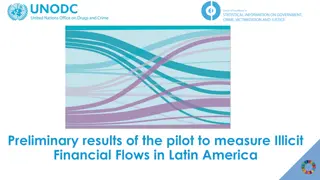Unveiling the Mysteries of Solar Fields and Flows
Delve into the realm of solar physics with COFFIES, a Heliophysics DRIVE Science Center focused on understanding the dynamic interplay between solar flow fields and magnetic forces. By studying plasma motions, magnetic field interactions, and emergence of active regions, COFFIES aims to revolutionize our ability to forecast solar activity cycles and magnetic variability. Through collaboration and data-driven models, this center seeks breakthrough discoveries in solar science.
Download Presentation

Please find below an Image/Link to download the presentation.
The content on the website is provided AS IS for your information and personal use only. It may not be sold, licensed, or shared on other websites without obtaining consent from the author.If you encounter any issues during the download, it is possible that the publisher has removed the file from their server.
You are allowed to download the files provided on this website for personal or commercial use, subject to the condition that they are used lawfully. All files are the property of their respective owners.
The content on the website is provided AS IS for your information and personal use only. It may not be sold, licensed, or shared on other websites without obtaining consent from the author.
E N D
Presentation Transcript
COFFIES Consequences Of Fields and Flows in the Interior and Exterior of the Sun A Heliophysics DRIVE Science Center J. Todd Hoeksema, Stanford University 1
COFFIES Consequences of Flows and Fields in the Interior and Exterior of the Sun The COFFIES Vision Expand our understanding of the Sun to develop the capability to forecast activity cycles and magnetic field variability by creating a diverse and inclusive center of excellence in Solar Physics To develop data-driven models of solar activity such that accurate measurements of 3D plasma flows in the Sun can drive a reliable physical model of the solar activity cycle and consequent magnetic field evolution
Heliophysics DRIVE Science Centers DSCs address grand challenge goals that are both ambitious and focused enough to be achievable within the 5yr lifetime of a center, i.e. problems poised and ready for major advance. DSCs enable science that cannot effectively be done by individual investigators. DSCs support collaboration and deep knowledge integration across a range of expertise COFFIES was one of three DSCs selected for Phase II in 2022 3
COFFIES Strategic Goal Breakthrough Science: By the end of this project, we will understand the nature of the interior solar flow fields, how they generate and interact with the interior magnetic fields, and how the interior magnetohydrodynamics leads to the solar cycle, as evidenced by sunspots and magnetic fields on the solar surface. Based on the knowledge gained, we will be able to predict where new active regions are likely to emerge and forecast properties of future activity cycles based on helioseismic inferences, surface observations including magnetograms and Doppler shifts, as well as magnetic-field and plasma-flow features and patterns. 4
COFFIES Top Science Questions COFFIES brings together science and cross-cutting teams to answer the difficult questions of 1. What drives varying large-scale plasma motions, such as meridional flow and differential rotation? 2. How do flows interact with magnetic fields to create varying solar activity cycles? 3. What causes active regions to emerge when and where they do during the solar cycle? 4. How is our understanding of solar activity informed by fields and flows on other stars?
COFFIES Outcomes Science Goals: Understand how the Sun and stars generate quasi-periodic magnetic activity cycles Advance fully 3D physical models of solar and stellar interior dynamics and convection Establish the physical links between flow fields and evolving near-surface observations Develop robust helioseismic techniques to confidently resolve solar interior flows Broader Goals: Involve STEM students and the public in the excitement of COFFIES and Heliophysics science Advance Diversity, Equity, Inclusion, and Accessibility in the COFFIES and Heliophysics community Leave an enduring legacy in Heliophysics by mentoring graduate students, post-docs, and early-career scientists
COFFIES Themes and Teams Themes: Tachocline Flux Transport & Emergence Near Surface Shear Layer Science Teams Dynamo Convection Helioseismology Surface Links Model Integration Leadership Center Effectiveness Broadening Impacts
COFFIES Science THEMES Tachocline, Flux Transport & Emergence, Near-Surface Shear Layer COFFIES seeks to explain solar activity by understanding how motions within the Sun influence its magnetic field on various time scales. This cut- away schematic of the solar interior shows the regimes of interest and suggests where progress can be made by linking models and observations. Flux observed to emerge at the surface reflects the sources of magnetic field that arise because of the interplay of convection, meridional flow, and differential rotation in the outer layers of the Sun. Measurements of flow fields at different depths indicate where magnetic field can be amplified and distorted. These are reflected in our three themes: the Tachocline, Flux Transport and Emergence, and the Near-Surface Shear Layer. 9
The Tachocline N. Brummel & G. Guerrero The surprisingly thin tachocline is confined to the bottom of the convection zone. The characteristics of the solar cycle and the temporally and spatially varying conditions in the tachocline indicate that it is not just a passive boundary between the differentially rotating convection zone and the rigidly rotating core. Competing explanations of the stresses that create and maintain the tachocline can now be modeled with greater fidelity, enough that observations of the deep interior will be able distinguish among them. Beyond the question of its origin, the role the tachocline plays in generating the cycle s magnetic flux is not well understood. With better understanding of the dynamics of the tachocline, model simulations of the dynamo can be improved. While promising, there is no guarantee that improved dynamics will necessarily constrain current models in a sufficient way. An important key to this will be the understanding and removal of systematic errors in helioseismic analysis that will enable us to distinguish between models that operate exclusively in the convection zone from those that penetrate into the radiative zone. Ultimately flux emerges in smaller concentrations that correspond to active regions or nests of solar activity. The triggers for emergence may be manifest in improved observations and modeling of the tachocline. How a magnetic flux structure at the CZ base becomes buoyant is a topic for both the Tachocline and Flux Transport and Emergence Themes.
Flux Transport & Emergence W. Abbett & A. Norton Patterns of flux emergence at the surface including Hale s polarity law, Joy s orientation law, clustering of activity in nests, and systematic variations in helicity, zonal flow, meridional flow, and the polar fields put constraints on the generation and emergence of magnetic field on various time scales. However, the constraints are not as strong as once believed. The development of buoyant emerging flux tubes in the deep interior is traditionally accepted and certainly appeals; however, recent radiative MHD near-surface magnetoconvection models can also generate bipolar magnetic regions without pre-existing flux structures. Near-surface and deep-seated global models have similar ambiguities, due in part to the inability to comprehensively model the entire convection zone. The range of physical parameters is simply too great to consistently treat the deep interior and the rapidly changing conditions near the surface. Finding ways to link these models and at the same time account for the local and global observations is one of the big challenges for COFFIES. Our breakthrough goals are to determine the physical mechanisms underlying the observed characteristic of emergence of ARs, to better understand the implications of magnetic helicity, and understand what the presence of activity clusters reveal about the triggers and persistence of flux emergence. These activities require participation of all of the traditional science teams.
Near-Surface Shear Layer R. Komm & N. Featherstone Differential rotation is reduced significantly in the top 35 Mm of the convection zone. Unlike the tachocline, this region is accessible to higher-resolution local helioseismology techniques and linked more closely to surface manifestations of convection that can be more directly detected in the photosphere. There is currently no comprehensive explanation for the creation, maintenance, and dynamics of the NSSL. Supergranulation, gyroscopic pumping, and thermal wind balance all play a role, but do not explain observations at all latitudes. Nor are the time-varying characteristics of this region well known on shorter time scales. In some ways the NSSL masks conditions at greater depths. Deep-seated convection clearly sustains differential rotation, but why are the near-surface signatures of those patterns so weak? Current models do not fully explain how solar convection transports energy and drives differential rotation with such apparently weak flows; this is affectionately called the convective conundrum. Improved modeling capabilities and better observations of conditions in the top 5-10% of the CZ should allow a breakthrough in understanding the apparently critical role of the NSSL. Finally, the NSSL is related to broader dynamo processes. Both emerging and submerging flux observed at the surface passes through this layer. How strongly the NSSL mediates the generation and timing of large- and small-scale magnetic patterns and transport is unclear. To the extent that surface flux patterns are related to future cycles, the surface poloidal field must be pumped back into the interior where the subsequent cycle s toroidal field is generated. The contributions of meridional circulation and turbulent pumping to this submersion press is at this point unclear.
COFFIES Science Teams Primary Science Teams Dynamo Convection Helioseismology Surface Links Model Integration
Dynamo Team The Dynamo Team (A. Kosovichev & G. Guerrero) brings skills in numerical simulation to investigate mechanisms of solar-cycle variations that depend on varying differential rotation and meridional circulation. They employ a variety of global and local, 2D and 3D dynamo models to investigate creation, emergence, transport, and decay of flux in the Sun and Sun-like stars throughout the convection zone. 14
Dynamo Team WG-D1: Dynamo Modeling Task D1.1: Solar dynamo numerical simulations Task D1.2: Rossby waves in global simulations Task D1.3: Local and global modeling of dynamos in F, G, and K stars Task D1.4: Evolution of toroidal fields in stable (radiative) layers Task D1.5: Dynamo processes in the tachocline Task D1.6: Mean-field MHD dynamo modeling WG-D2: Emerging magnetic flux Task D2.1:Non-axisymmetric instabilities of the toroidal field in the tachocline modeling active nests. Task D2.2. 3D Babcock-Leighton models WG-D3: Comparison of dynamo models with observations Task D3.1: Solar-cycle variations of differential rotation Task D3.2. Forward modeling helioseismic signatures of meridional circulation FUTURE: Restructuring of WG tasks to merge with other teams 15
Convection Team The Convection Team (N. Brummell & N. Featherstone) has significant overlap with the Tachocline Theme. They investigate instability processes, such as convection, shear, and buoyancy, as well as flow generation, and transport of waves, heat, angular momentum, composition, and flux. Foci include tachocline dynamics along with deep seated magnetic flux creation, structure, and dynamics. 16
Convection Team WG-C1: Tachocline dynamics WG-C2: Magnetic flux structure creation and evolution WG-C3: Novel dynamo mechanisms Future: Investigate CZ dynamics that encompass varying degrees of rotational influence Investigate the existence and dynamics of the near-surface shear layer (NSSL) 17
Helioseismology Team The Helioseismology Team (R. Komm & R. Chen) uses the signatures of acoustic waves in the solar interior to measure flows on various temporal and spatial scales, including differential rotation and meridional flows. They seek for signatures of fields and flows below the surface and map the 3D structure and dynamics from the near surface down to the tachocline and beyond. The HS Team is working to reconcile results from various helioseismic techniques and reduce systematic errors that limit accuracy at all depths. 18
Helioseismology Team WG-H1: Reconciling methods WG-H2: Differential Rotation WG-H3: Sound Speed Variations WG-H4: Systematic HS Effects Future: Establish points of contact between theory, models, & observations to: determine how helioseismic observations from three solar cycles can help to constrain the parameter space of convection and dynamo models, derive reliable measurements of helicity transport from the interior to the surface, and investigate the near-surface shear layer 19
Surface Links Team The Surface Links Team (W. Abbett & J.T. Hoeksema) measures surface and near surface conditions with an eye toward understanding the links between evolving surface patterns and conditions beneath the surface. They determine changing characteristics of flux emergence, surface flow fields, helicity, cross-equatorial flows, active- region parameters, and long- and intermediate-term flux patterns. They look for persistent structures in both latitude and longitude. 20
Surface Links Team WG-L1: AR Properties Task L1.1: Investigate patterns of active longitudes and non-axisymmetric patterns of AR emergence. Task L1.2: Systematically measure initial and evolving tilt angles of ARs Task L1.3: Investigate the occurrence, causes, and effects of Rogue ARs WG-L2 : Surface Flows Task L2.1: Create, collect, and reconcile measurements of photospheric flow patterns Task L2.2: Link surface measurements of flow patterns to near-surface HS results Task L2.3: Understand uncertainties and validate interpretation of results with detailed flux models Task L2.4: Compare with results of Dynamo and Convection modeling; provide constraints on models WG-L3: Polar Field Origins Task L3.1: Improve Surface Flux Transport modeling to incorporate detailed measurements Task L3.2: Investigate sensitivity of polar field to variations in flows and flux emergence parameters and relate to results of Dynamo and Convection Teams WG-L4 Near-Surface Flux Emergence Task L4.1: Develop and improve model of flux emergence through the outer convection zone Task L4.2: Use predicted characteristics of magnetic field in the interior to drive flux emergence code Task L4.3: Compare observed characteristics with results of WG-L1 to constrain interior flux generation models WG-L5: Helicity 21
Model Integration Team The Model Integration Team (I. Kitiashvili, D. Lauben & A. Wray) plays multiple roles. They facilitate interactions among modelers and observers. They assist with the sharing of data and codes and the development of frameworks for linking inputs and outputs of simulations and data. The team also coordinates modeling activities and helps COFFIES researchers identify and complete high- priority products for the Center that can be passed on at the end of the project. 22
Model Integration Team WG-M1: Modeling Technology Task M1.1: Enhance performance of codes Task M1.2: Develop solar/stellar models to investigate interconnections between different dynamical and temporal scales. Task M1.3: Develop codes to model global solar variability and build a reliable global-variability forecast tool. Task M1.4: Develop capabilities for code intercommunication Task M1.5: Develop a cooperative infrastructure of relevant codes WG-M2: Machine Learning Task M2.1: Predict global solar activity in terms of sunspot number, active region area, and evolution of magnetic fields Task M2-2: Generate homogeneous magnetograms and Dopplergrams to obtain consistent long-term time-series. Task M2-3: Develop methods for ML-infused synthesis of the observables, fast multi-instrument techniques for analysis of observations, and automatically identify structural and dynamical features). WG-M3: Databases Task M3-1: Make models, synthetic observables, and data products publicly available through the Helioportal Task M3-2: Develop ML-ready and data-assimilation-ready self-updated databases. Task M3-3: Develop user-support tools for effective integration, data retrieval, analysis, and visualization of the ML- and Global Solar Variability databases for the needs of the COFFIES community and beyond. 23
Center Effectiveness Team L. Upton & S. Hess Webber The CET focuses on finding and exploring novel ways to enable to the science teams achieve breakthrough science. A distributed Science Center faces a number of well documented challenges, and the CET helps COFFIES function effectively as a team. They provide support for communications, collaboration, knowledge integration, and for engagement beyond the COFFIES team. 24
Broadening Impacts D. Zevin, B. Mendez, J. Jackiewicz Education and Outreach Dan Zevin COFFIES will organize an annual REU program providing diverse undergraduates with authentic research experiences to spark their interest in STEM, expand professional networks and communication skills, and cultivate a sense of possible self that includes careers in solar physics, NASA, and academia in general. We also plan a Public Outreach and Informal Science Education (POISE) program to engage the general public. We leverage experience with the UCB Space Science Lab and Lawrence Hall of Science who have extensive experience with Science on a Sphere programs. Mentoring Jason Jackiewicz The COFFIES Beans program serves students and early career researchers by fostering professional identity and establishing mentoring relationships with COFFIES Members. Activities include external and near-peer mentorship opportunities with a researcher outside their existing network and peer buddies from another institution; Mentoring opportunities for Beans to meet with REU students; Regularly scheduled professional development activities; virtual and in-person meetings; and Opportunities for public engagement. Diversity, Equity, Inclusion and Accessibility Bryan Mendez Diversity is a strength that drives innovation, creativity and engagement. We are committed to modeling diversity and inclusion for the scientific community, and to maintaining an inclusive environment with equitable treatment for all. We will research and develop tools and best practices to implement in our management structure and education programs that ensure a welcoming, nurturing and robustly inclusive community. 25
COFFIES Co-Investigator Team Stanford University Todd Hoeksema Dave Lauben Shea Hess Webber Ruizhu Chen Aimee Norton Yang Liu Junwei Zhao Phil Scherrer Rick Bogart New Jersey Institute of Technology Sasha Kosovichev Gustavo Guerrero Andrej Stejko National Solar Observatory Rudi Komm Kiran jain Sushanta Tripathy UC Santa Cruz Nick Brummell UC Berkeley Bill Abbett Dave Bercik Dan Zevin John Erickson Bryan Mendez SouthWest Research Institute (SWRI) Lisa Upton Andrez munoz Jaramillo Nick Featherstone High Altitude Observatory / NCAR Mausumi Dikpati Smithsonian Astrophysical Observatory Sylvain Korzennik New Mexico State University Jason Jackiewicz NASA Ames Research Center Alan Wray Irina Kitiashvili Lockheed Martin Marc DeRosa Georgia State University Slava Sadykov Dustin Kempton NorthWest Research Associates (NWRA) Doug Braun Instituto Nazionale di AstroFisica A. Bonanno University of Glasgow R. Simitev Institute for Solar-Terrestrial Physics V. Pipin Max Planck Inst. for Solar System Research J. Warnecke 27





